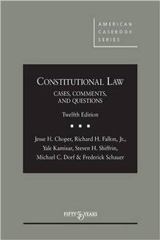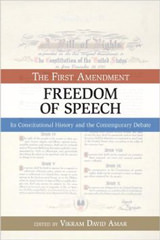Now that the U.S. Supreme Court’s most recent term has wrapped up, there will be much analysis of specific rulings that affect particular and important constitutional doctrines (indeed one or both of us will be writing about many of these rulings in various fora soon), but it is also important at this time to take a step back to reflect a bit on constitutional interpretation and application more generally.
Although some of the Constitution’s provisions relate to religion, the Constitution is not a theological document. It is not scripture. It expresses the words of mere mortals, not the word of G-d.
But for constitutional law to work effectively and to fulfill the promise of the document’s preamble, “We the People” have to recognize the importance of grounding the interpretation of the Constitution on something that does have religious overtones—the Golden Rule. That is, do unto others as you would have others do unto you.
What this means for constitutional law purposes really isn’t all that complicated. But it is difficult to accomplish, because it requires people to subordinate some of their own substantive desires and perceived needs in the service of a higher principle—the even-handed application of constitutional structures and mandates. Put simply, in this context the Golden Rule means that the Constitution protects the other guy to the same extent that it protects us. The government must treat the other guy the way we want it to treat us.
There are so many examples of the importance of this core principle that it may seem odd that the principle itself needs to be continually repeated and reaffirmed. Yet the apparent failure to recognize and abide by this idea of constitutional reciprocity requires such repetition.
Perhaps the most constitutionally obvious set of examples involves free speech doctrine. For freedom of speech to serve its instrumental and dignitary purposes, it has to work the same way without regard to which people are speaking or what their message is.
Let us consider, for example, whether an activity should be understood to be protected speech at all, or unprotected conduct that government has every right to regulate provided government is doing so not because of the conduct’s communicative dimension. The understanding of this critical distinction cannot depend on the purpose or content of the individual’s activity. If, as part of an anti-abortion demonstration, obstruction of access to a clinic that provides abortion services is deemed conduct that can be regulated for non-censorial reasons, then so is obstruction of access to university buildings during an anti-Israel demonstration. Under the Golden Rule, determining whether obstruction can be regulated cannot depend on the cause advocated by those engaged in the obstructing conduct.
Or consider whether speech should be interpreted to be proscribable incitement rather than protected advocacy. Current law (Brandenberg v. Ohio) allows advocacy to be prohibited and punished only if it is “directed to inciting or producing imminent lawless action and is likely to produce such action.” This can be a costly principle to respect. Speech that may well cause some audience members to engage in unlawful conduct or violence that harms others somewhere down the road in very palpable ways is protected as long as the risk of such harms is not imminent, even if the downstream violence is in fact a (delayed but clear) consequence of the speech.
That price, however, cannot change if the speaker expresses a far Left rather than a far Right message. And imminence must have the same meaning without regard to the political perspective of the advocacy. We cannot pick and choose what constitutes incitement depending on whether we agree with the cause promoted by the speaker. Liberals who argue that anti-immigrant speech incites unlawful conduct or violence against immigrants must apply the same understanding of incitement to anti-Israel protests that some people believe cause unlawful conduct or violence to be visited upon Zionist Jews. And vice versa.
The Golden Rule of constitutional interpretation extends to constitutional structures as well as individual rights. For decades, liberals denounced the idea that the Constitution limited federal power in the name of states’ rights when that principle was being asserted to challenge federal civil rights laws. Today, however, the shoe is on the other foot, and conservatives complain that state autonomy should not hinder the federal government’s ability to implement the current administration’s agenda.
To cite a more specific example, in Printz v. United States in 1997 the Court proclaimed that the Constitution’s commitment to federalism included an anti-commandeering principle. Pursuant to this mandate, the federal government could not require state and local officers to enforce federal law. Accordingly, local law enforcement could not be ordered to help enforce federal gun-control statutes.
One can certainly challenge the Court’s reasoning in Printz. But many people, including many opponents of gun-control laws, supported the anti-commandeering principle that made it more difficult for the federal government to accomplish background checks on gun purchases. Today, however, it is Blue states who are asserting this same anti-commandeering principle in refusing to assist ICE and other federal law enforcement agents as they seek to implement the federal government’s deportation policies. Again, if the anti-commandeering principle is good law, its application cannot depend on the substantive policy at issue unless there is a principled (that is, grounded in the Constitution) distinction between immigration and gun-control laws. For general constitutional structural purposes, opponents and supporters of federal government gun-control policies and immigration laws cannot pick and choose. The anti-commandeering principle should apply across the board.
The same lessons emerge when we analyze not federalism (which anti-commandeering implicates) but the other of the two most important structural constitutional themes: separation of powers, including the respect for judicial review. Many people today worry about the Rule of Law and whether government actors like the President and others in the executive branch might wrongfully defy or flout judicial rulings from the Supreme Court. And that concern may be warranted in the current climate. But if the President cannot, when seeking to deport non-citizens, flout Supreme Court rulings involving due process (which is mentioned in both the Fifth and Fourteenth Amendments), then other government actors, including public universities, cannot circumvent or flout Supreme Court rulings about equal protection (also housed in the Fourteenth Amendment) in, say, the racial affirmative action setting. And just as liberals have reason to worry about defiance by the President, so too conservatives have cause to wonder whether state and local governments are really complying with the Court’s rulings in Students for Fair Admissions v. President and Fellows of Harvard College and Students for Fair Admissions v. University of North Carolina(SFFA). If the other guy is required to obey Supreme Court decisions because of the Rule of Law, then you also have to obey decisions that strike you as fundamentally wrong-headed and unfair. Either you believe in the constitutional principle of obedience to Supreme Court edicts or you don’t. You can’t pick and choose which rulings of law are part of the Rule of Law.
Mention of these last cases reminds us that application of the Golden Rule of constitutional interpretation kicks in only when the same constitutional principle is at stake in different settings and circumstances. If the principle at issue is itself disputed as to its meaning, however, we should not be surprised that good-faith disagreements as to what the Golden Rule requires will arise.
For example, some jurists argue that the principle underlying the Equal Protection Clause is the need to protect certain classes of persons from oppressive laws adopted by the majority. Under this analysis, laws burdening historically victimized minorities who may lack the political power to protect their own interests, such as African Americans, will be subject to rigorous constitutional review. But a law, such as an affirmative action program, that burdens a racial majority that has not experienced virulent discrimination in the past would receive more lenient scrutiny, because White Americans are not a class of persons the Equal Protection Clause specially protects.
An alternative understanding of the Equal Protection Clause focuses on the classification employed in a challenged statute, not the identity of the class of persons burdened by the law. From this perspective, conservative Justices believe it is racial classifications themselves that are inherently problematic for constitutional purposes, regardless of whether the racial classification at issue helps or hurts majorities or minorities. Accordingly, as the Court has recently ruled, the Equal Protection Clause prohibits virtually all racial classifications, whether the group receiving favorable or unfavorable treatment is the White majority or a Black minority group. That is the vision underlying the SFFA cases. What is important here is that if the conservatives on the Court are correct that equal protection principles focus not on groups or classes of persons, but instead on particularly odious classifications, then there is no violation of the Golden Rule (indeed it is an application of the Golden Rule) to invalidate laws that stigmatize African Americans (as the segregation at issue in Brown v. Board of Education did), and yet to also invalidate laws that seek to help African Americans (as the programs in SFFA purportedly did), because classifications, rather than groups, are what the Constitution frowns on.
However, in last week’s United States v. Skrmetti ruling, some of those very conservatives invoked not classification analysis, but group-based class analysis, to reject applying meaningful review to a law that by its terms focused on transgender individuals and their medical decisions. The seeming inconsistency between their analysis in Skrmetti and their disregard of group-based analysis in SFFA does require much more explanation, lest it appear to run afoul of the Golden Rule.
There are numerous other examples that could be cited to illustrate the importance of the Golden Rule of constitutional interpretation. And there may be legitimate disagreements as to how the Rule should be applied in any given instance. Constitutional interpretation is much like scriptural interpretation in that sense; agreement on basic principles still leaves some room for differences in their application. But principles preclude some kinds of arguments or outcomes. The Golden Rule of constitutional interpretation precludes the argument that rights and structures only support and protect the causes the two of us endorse but provide no benefit to proponents of other causes.
As we all make our way through the Court’s work this term, having that single (rather than double) standard in mind as a yardstick would serve us well.









